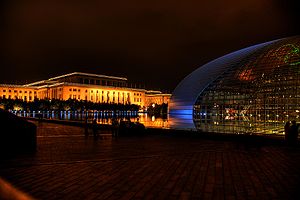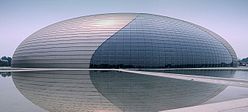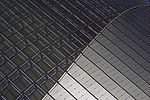
China National Grand Theatre
Encyclopedia
The National Centre for the Performing Arts (NCPA) , and colloquially described as The Bird's Egg, is an opera house
in Beijing
, People's Republic of China
. The Centre, an ellipsoid dome of titanium
and glass surrounded by an artificial lake, seats 5,452 people in three halls and is almost 12,000 m² in size. It was designed by French architect Paul Andreu
. Construction started in December 2001 and the inaugural concert was held in December 2007.
 The exterior of the theater is a titanium
The exterior of the theater is a titanium
accented glass dome that is completely surrounded by a man-made lake. It is said to look like an egg floating on water, or a water drop. It was designed as an iconic feature, something that would be immediately recognizable.
The dome measures 212 meters in east-west direction, 144 meters in north-south direction, and is 46 meters high. The main entrance is at the north side. Guests arrive in the building after walking through a hallway that goes underneath the lake. The titanium shell is broken by a glass curtain in north-south direction that gradually widens from top to bottom.
and the Great Hall of the People
, and near the Forbidden City
, combined with the theatre's futuristic design, created considerable controversy. Paul Andreu
countered that although there is indeed value in ancient traditional Chinese architecture, Beijing must also include modern architecture, as the capital of the country and an international city of great importance. His design, with large open space, water, trees, was specially designed to complement the red walls of ancient buildings and the Great Hall of the People
, in order to melt into the surroundings as opposed to standing out against them.



 Internally, there are three major performance halls:
Internally, there are three major performance halls:
.
When the construction had completed, the total cost rose to more than ¥
3.2 billion CNY. The major cause of the cost increase was a delay for reevaluation and subsequent minor changes as a precaution after a Paris
airport terminal building collapsed. The cost has been a major source of controversy because many believed that it is nearly impossible to recover the investment. When the cost is averaged out, each seat is worth about ¥
half a million CNY. The Chinese government answered that the theater is not a for profit venture.
The government sanctioned study completed in 2004 by the Research Academy of Economic & Social Development of Northeast University of Finance and Economics, of the upkeep costs of the building were publicized in domestic Chinese media:
The water and electricity bills and the cleaning cost for the external surface would be at least tens of millions CNY, and with other maintenance cost, the total could easily exceed one billion CNY. Therefore, at least 80 percent of the annual operational costs must be subsidized by the government for at least the first three years after the opening, and for the rest of its operational life, at least 60 percent of the annual operational cost must be subsidized by the government.
The director of the art committee of the National Centre for the Performing Arts and the standing committee member of the Standing Committee of the Chinese People's Political Consultative Conference
, Mr Wu Zuqiang (吴祖强) and the publicist / deputy director of the National Centre for the Performing Arts Mr Deng (邓一江) have announced that 70 percent of the tickets would be sold at low price for ordinary citizens, while 10% of the tickets would be sold at relatively expensive prices for separate market segments, and the 60% of annual operational cost needed to be subsidized by the government would be divided between the central government and the Beijing
municipal government.
Opera house
An opera house is a theatre building used for opera performances that consists of a stage, an orchestra pit, audience seating, and backstage facilities for costumes and set building...
in Beijing
Beijing
Beijing , also known as Peking , is the capital of the People's Republic of China and one of the most populous cities in the world, with a population of 19,612,368 as of 2010. The city is the country's political, cultural, and educational center, and home to the headquarters for most of China's...
, People's Republic of China
People's Republic of China
China , officially the People's Republic of China , is the most populous country in the world, with over 1.3 billion citizens. Located in East Asia, the country covers approximately 9.6 million square kilometres...
. The Centre, an ellipsoid dome of titanium
Titanium
Titanium is a chemical element with the symbol Ti and atomic number 22. It has a low density and is a strong, lustrous, corrosion-resistant transition metal with a silver color....
and glass surrounded by an artificial lake, seats 5,452 people in three halls and is almost 12,000 m² in size. It was designed by French architect Paul Andreu
Paul Andreu
Paul Andreu is a renowned French architect. He is best known for having planned numerous airports worldwide, notably Ninoy Aquino International Airport , Soekarno-Hatta International Airport , Shanghai Pudong International Airport Abu Dhabi International Airport, Dubai International Airport,...
. Construction started in December 2001 and the inaugural concert was held in December 2007.
Materiality

Titanium
Titanium is a chemical element with the symbol Ti and atomic number 22. It has a low density and is a strong, lustrous, corrosion-resistant transition metal with a silver color....
accented glass dome that is completely surrounded by a man-made lake. It is said to look like an egg floating on water, or a water drop. It was designed as an iconic feature, something that would be immediately recognizable.
The dome measures 212 meters in east-west direction, 144 meters in north-south direction, and is 46 meters high. The main entrance is at the north side. Guests arrive in the building after walking through a hallway that goes underneath the lake. The titanium shell is broken by a glass curtain in north-south direction that gradually widens from top to bottom.
Location
The location, immediately to the west of Tiananmen SquareTiananmen Square
Tiananmen Square is a large city square in the center of Beijing, China, named after the Tiananmen Gate located to its North, separating it from the Forbidden City. Tiananmen Square is the third largest city square in the world...
and the Great Hall of the People
Great Hall of the People
The Great Hall of the People is located at the western edge of Tiananmen Square, Beijing, People's Republic of China, and is used for legislative and ceremonial activities by the People's Republic of China and the Communist Party of China. It functions as the People's Republic of China's...
, and near the Forbidden City
Forbidden City
The Forbidden City was the Chinese imperial palace from the Ming Dynasty to the end of the Qing Dynasty. It is located in the middle of Beijing, China, and now houses the Palace Museum...
, combined with the theatre's futuristic design, created considerable controversy. Paul Andreu
Paul Andreu
Paul Andreu is a renowned French architect. He is best known for having planned numerous airports worldwide, notably Ninoy Aquino International Airport , Soekarno-Hatta International Airport , Shanghai Pudong International Airport Abu Dhabi International Airport, Dubai International Airport,...
countered that although there is indeed value in ancient traditional Chinese architecture, Beijing must also include modern architecture, as the capital of the country and an international city of great importance. His design, with large open space, water, trees, was specially designed to complement the red walls of ancient buildings and the Great Hall of the People
Great Hall of the People
The Great Hall of the People is located at the western edge of Tiananmen Square, Beijing, People's Republic of China, and is used for legislative and ceremonial activities by the People's Republic of China and the Communist Party of China. It functions as the People's Republic of China's...
, in order to melt into the surroundings as opposed to standing out against them.
Performance and other venues




- The Opera Hall is used for operas, ballet, and dances and seats 2,416.
- The Music Hall seats 2,017 seats.
- The Theater Hall is used for plays and the Beijing operaBeijing operaPeking opera or Beijing opera is a form of traditional Chinese theatre which combines music, vocal performance, mime, dance and acrobatics. It arose in the late 18th century and became fully developed and recognized by the mid-19th century. The form was extremely popular in the Qing Dynasty court...
. It has 1,040 seats.
Cost
The initial planned cost of the theatre was 2.688 billion RenminbiRenminbi
The Renminbi is the official currency of the People's Republic of China . Renminbi is legal tender in mainland China, but not in Hong Kong or Macau. It is issued by the People's Bank of China, the monetary authority of the PRC...
.
When the construction had completed, the total cost rose to more than ¥
¥
¥ is a currency sign used by the Japanese yen and the Chinese yuan currencies. The symbol resembles a Latin letter Y with a double stroke. The base unit of both currencies shared the same Chinese character pronounced yuán in Mandarin Chinese and en in Standard Japanese...
3.2 billion CNY. The major cause of the cost increase was a delay for reevaluation and subsequent minor changes as a precaution after a Paris
Paris
Paris is the capital and largest city in France, situated on the river Seine, in northern France, at the heart of the Île-de-France region...
airport terminal building collapsed. The cost has been a major source of controversy because many believed that it is nearly impossible to recover the investment. When the cost is averaged out, each seat is worth about ¥
¥
¥ is a currency sign used by the Japanese yen and the Chinese yuan currencies. The symbol resembles a Latin letter Y with a double stroke. The base unit of both currencies shared the same Chinese character pronounced yuán in Mandarin Chinese and en in Standard Japanese...
half a million CNY. The Chinese government answered that the theater is not a for profit venture.
The government sanctioned study completed in 2004 by the Research Academy of Economic & Social Development of Northeast University of Finance and Economics, of the upkeep costs of the building were publicized in domestic Chinese media:
The water and electricity bills and the cleaning cost for the external surface would be at least tens of millions CNY, and with other maintenance cost, the total could easily exceed one billion CNY. Therefore, at least 80 percent of the annual operational costs must be subsidized by the government for at least the first three years after the opening, and for the rest of its operational life, at least 60 percent of the annual operational cost must be subsidized by the government.
The director of the art committee of the National Centre for the Performing Arts and the standing committee member of the Standing Committee of the Chinese People's Political Consultative Conference
Chinese People's Political Consultative Conference
The Chinese People's Political Consultative Conference [], shortened as 人民政协, Rénmín Zhèngxié, i.e. "People's PCC"; or just 政协, Zhèngxié, i.e. "The PCC"), abbreviated CPPCC, is a political advisory body in the People's Republic of China...
, Mr Wu Zuqiang (吴祖强) and the publicist / deputy director of the National Centre for the Performing Arts Mr Deng (邓一江) have announced that 70 percent of the tickets would be sold at low price for ordinary citizens, while 10% of the tickets would be sold at relatively expensive prices for separate market segments, and the 60% of annual operational cost needed to be subsidized by the government would be divided between the central government and the Beijing
Beijing
Beijing , also known as Peking , is the capital of the People's Republic of China and one of the most populous cities in the world, with a population of 19,612,368 as of 2010. The city is the country's political, cultural, and educational center, and home to the headquarters for most of China's...
municipal government.
External links
- Slideshow from the Guardian UnlimitedGuardian Unlimitedguardian.co.uk, formerly known as Guardian Unlimited, is a British website owned by the Guardian Media Group. Georgina Henry is the editor...
- National Grand Theater of China: a steel architecture case study on Constructalia
- Robbie Moore, "Left of the Forbidden City", Specifier Magazine online, date unk. Profile of the Centre retrieved 11 May 2008
- National Grand Theater of China, Beijing
- "National Grand Theater of China, Beijing" at website of Paul Andreu
- The water control valves in National Grand Theater of China

